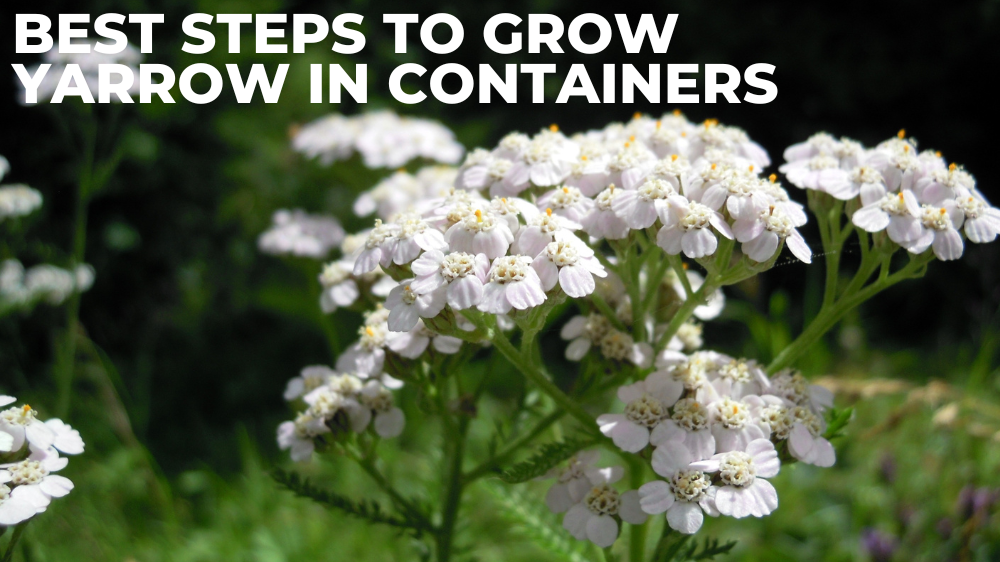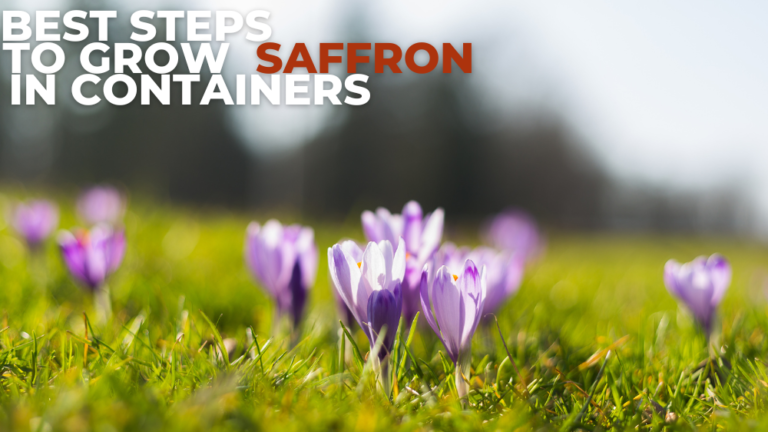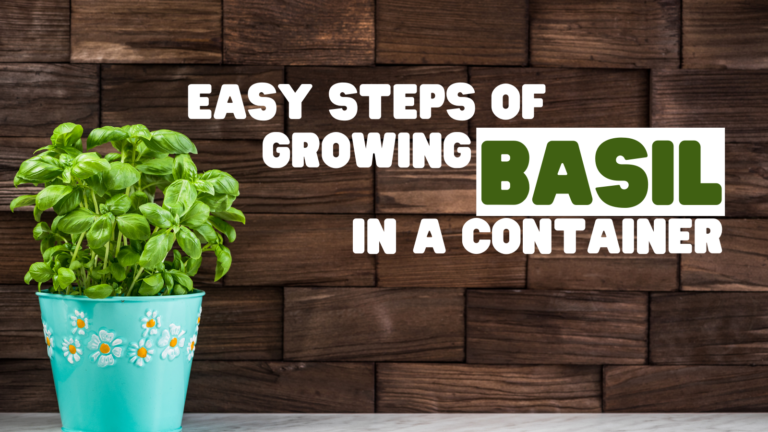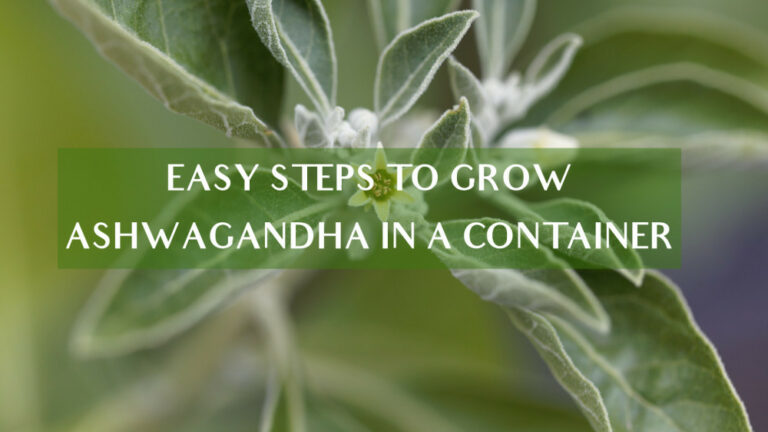Best Steps To Grow Yarrow In Containers
Best Steps To Grow Yarrow In Containers
On a deck or patio in the sun, yarrow grows well as a perennial plant in containers. They work well as filler plants in mixed seasonal plantings and can also be used singly in container garden arrangements.
Perennials in pots can flourish happily with just a bit more care than they require when planted in the garden.
Plants grown in containers cannot stretch their roots for water or nourishment. Thus, they must rely solely on the gardener's care.
History & Origin Of Yarrow
Yarrow has been used in medicine and food for thousands of years. In Iraq, 60,000-year-old Neanderthal burial caves contain fossilized yarrow pollen. A present from Mother Earth herself that would provide herbal treatments for ages.
The notion that yarrow has historical roots in Ancient Greece is one of our favorite yarrow facts. According to Greek legend, Achilles' mother doused him in yarrow tea as soon as he was born while holding him by the ankle. An ankle wound was the only area the yarrow bath missed when he passed away as the Trojan War's champion.
As a result, yarrow was given the Greek name Achillea millefolium. During the Trojan War, Yarrow was used to reduce soldier wound bleeding during the Trojan War and those conflicts that followed.
Yarrow leaves have been used to cure wounded warriors on numerous battlefields, earning it the titles “soldier's woundwort” and “warrior herb.” Yarrow was utilized in ancient China to revitalize the mental forces of spirituality.
It was also believed to balance yin and yang energy, uniting heaven and earth. The Chinese employed yarrow stems as a divination instrument during the I-Ching dynasty.
Native Americans in North America utilized this herb to treat tooth, head, and earaches to reduce pain and inflammation.
Native Americans also used yarrow-based treatments to lower fevers and encourage sound sleep patterns. Tribes drank yarrow tea and utilized dried yarrow.
To keep flies and mosquitoes away, tribes utilized dried yarrow and yarrow tea. In ceremonial contexts, the herb was cooked to cleanse any disease from where sick people were laid down.
The Dakota of Teton Another moniker for yarrow that highlights its extraordinary qualities is “medicine for the wounded.”
Best Tips Of Growing Lemon Balm In Containers
Medical Uses Of Yarrow

1. Yarrow Oil Infusion
It's simple to create a yarrow oil infusion that can be used to treat bruises, inflamed muscles, and cuts.
In some circumstances, its astringent and anti-inflammatory properties may help to lessen varicose vein swelling.
You only need to crush up some dried leaves and flowers, put them in a glass jar, and then cover them with carrier oil in a 1:4 ratio—one part dried plant material to four parts oil.
You can use any premium neutral carrier oil of your choice, but I recommend cold-pressed extra virgin olive oil because it is readily available and reasonably priced.
For a few weeks, place the jar in a dark place, cover it tightly with a lid, and shake daily to stir the mixture.
For the first few days, you can also decide to leave the jar in the sun to allow the heat to infuse. Remember to relocate it to a cool, dark area for the remainder of the infusing period.
After 4-6 weeks, strain the oil and use it. You can also try melting beeswax and essential oils into an herbal salve. This can be kept in cool, dark places in tins or jars.
2. Making A Yarrow Salve
Use the oil to make a salve after soaking yarrow in it.
If you want to take the quick and simple route, warm up about ½ a cup of dried yarrow with 1 cup of coconut oil on the stove over low heat.
To allow the yarrow to infuse the coconut oil, combine everything and simmer for at least 20 minutes.
Put the infused coconut oil through a filter into a clean jar or container. Use on cuts, burns, rashes, bruises, insect bites, etc.
In addition, it can be used to rub on teething babies' gums in place of tinctures that contain alcohol.
You can infuse oil the same way as previously described to make a salve or by combining oil and dried yarrow in a jar and letting it sit for a while.
You can infuse oil the same way as described or wait for it to sit and infuse for about 4 to 6 weeks before using it to make a salve by combining dried yarrow and oil in a jar.
Use liquid oil, such as olive oil, sweet almond oil, or avocado oil, when infused oils in salves and other body products.
3. Garden Use Of Yarrow
It stands to reason that a plant with so many medicinal benefits would also benefit the garden.
And for several reasons, yarrow is a great plant to include in gardens. This plant has deep roots that ingest nutrients from the soil.
It can bring potassium, calcium, magnesium, phosphorus, and copper to the surface when used as mulch or added to the compost pile, enhancing the soil quality for other plants.
Some gardeners also make a tea fertilizer from yarrow instead of comfrey as a soil conditioner.
It also helps prevent erosion because it can grow in dry, poor soils and is drought tolerant. In xeriscaping, it is occasionally used as a drought-tolerant lawn replacement.
But there's more! Beneficial insects like predatory wasps, which consume common garden pests and pollinate other plants, are drawn to attractive flowers.
4. Yarrow Tincture
A tincture can be created using dried flowers and leaves. As previously mentioned, grind them up, put them in a glass jar, and then pour 80 proof (or more) alcohol over them. Infuse it for 6 to 8 weeks in a cool, dark location.
Place in a labelled dropper bottle after straining. When applied topically, the tincture can serve as a mosquito deterrent, but always test a small area first, especially if you have sensitive skin.
5. Yarrow Essential Oil
This sweet, green, and herbaceous-scented essential oil has astringent, antiseptic, and anti-inflammatory properties by nature.
It can be added to creams, lotions, or carrier oil to prevent a wound from becoming infected and hasten to heal.
It creates a covering to protect the wound and activates the blood's leukocytes and platelets (white blood cells that fight off foreign invaders).
Burning Yarrow essential oil in an oil burner will not only get rid of any germs and pathogens in the area but also help reduce respiratory tract and nasal passage inflammation, which will help with coughs and colds.
Massage Yarrow into aching, sore muscles after diluting it with carrier oil. It also makes a beautiful, soothing, and skin-friendly bath oil.
6. Ornamental Use Of Yarrow
Yarrow has been cultivated to produce several breathtaking cultivars for decorative use because of its beauty and popularity.
It gives perennial borders more interest, and the flowers are a lovely addition to bouquets of cut flowers.
You can choose from many pretty varieties to enhance the beauty and colour of your garden. You can purchase Yarrow seeds in various hues, including coral, gold, ivory, lilac, pink, rose, and yellow.
Types Of Yarrow
Many gardeners love yarrow, a vibrant plant with clusters of small heads of densely packed blossoms.
Although these little flowers appear in various colours, yellow, red, pink, and soft white are the most common.
Yarrow is a favourite among gardeners because of its tiny yet vibrant blossoms that draw butterflies. To grow yarrow in containers, you should know about the best varieties.
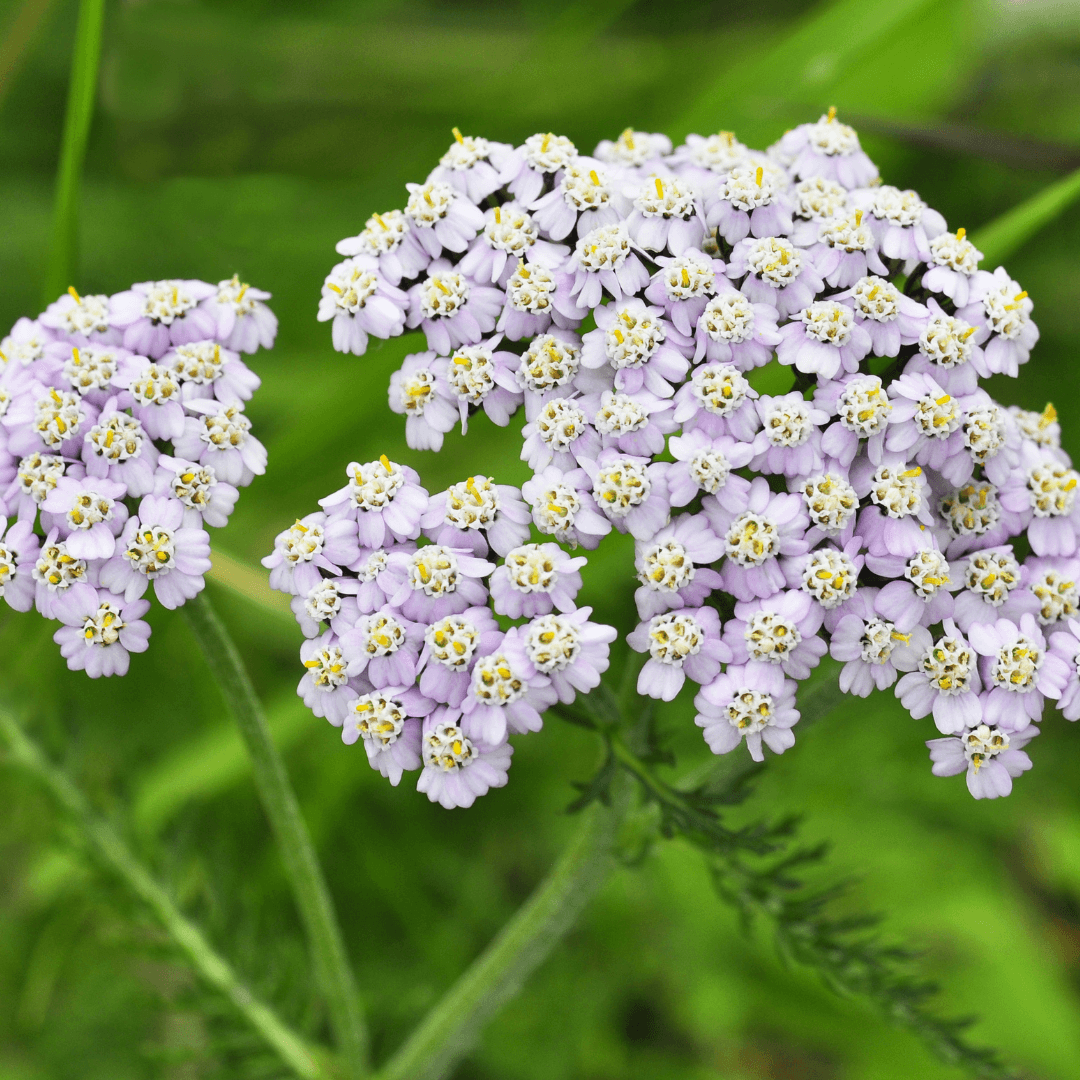
1. Apple Blossom Yarrow
These magnificent bloomers offer stunning bursts of princess pink flat-top flowers and are great garden highlights.
They are popular among gardeners for cutting purposes because they bloom from early to late summer. Their emerald-green foliage is vibrantly coloured all through the spring and summer.
2. Cerise Queen Yarrow (Achillea millefolium)
Throughout the summer, the cerise queen yarrow blooms in magenta and light pink hues for several weeks.
It is a striking type of yarrow with a sweet scent and light evergreen foliage. They are simple to maintain and resistant to various garden pests, including deer and rabbits.
The cerise queen can reach a height of two feet and does well in direct sunlight. They are common in border and cottage gardens.
These are quite good. Any gardener wishing to attract butterflies should choose these. In hardiness zones 3-9, they prosper.
3. Gold Yarrow (Achillea filipendulina)
Gold yarrow gets its name from its blossoms, which are a deep, brilliant yellow. They are simple to grow and resistant to deer and rabbits, just like most yarrow.
They thrive in zones 3 through 8 and have a lengthy blooming season of over 4 weeks.
4. Woolly Yarrow (Achillea tomentosa)
These bright yellow flowers, woolly yarrows, are supported by lush, evergreen foliage.
They benefit from full sunlight, regular or sandier soil, and little watering. They bloom from late spring to mid-summer and are deficient maintenance. They thrive in zones 3 through 9.
5. Moonshine Yarrow (Achillea millefolium)
Moonshine yarrow is an enthusiastic flowering lemon-yellow coloured flower that is frequently chosen for its summer blossoms. Its bright yellow blooms are maybe the palest shade of all.
Cutting the flower heads will ensure that blooms continue throughout the summer because it is an aromatic flower. They thrive in hardiness zones 3–9 and need minimal maintenance.
6. Wild Yarrow (Achillea ptarmica)
The dehydrator can dry the flowers and leaves, which can be used all year. The dried leaves and flowers have a pleasant and well-known fragrance, and the tea has a soothing and sweet flavour.
After the leaves have been separated from the stem, the tea tastes exactly how the leaves smell.
In the early summer, yarrow grows wild all over the farm. The bees and other pollinators adore it, typically white with a very slight pink tint.
Health Benefits Of Yarrow
A blooming plant called yarrow has been used for generations in traditional medicine to treat skin wounds and reduce inflammation.
Yarrow can also be used medicinally to treat neurological diseases, anxiety, and digestive issues.
1. Reduce Inflammation
The yarrow plant Achillea millefolium L. has several potential medicinal benefits, according to a 2017 review of the medical literature on the subject. It is used as a topical anti-inflammatory, which is one of those purposes.
Numerous research back up its anti-inflammatory effects. A 2017 study published in The Journal of Ethnopharmacology exhibited an “evident anti-inflammatory effect” that improved the skin's pH balance and moisture content.
2. Neurological Conditions
According to a 2017 Iranian study, Achillea millefolium effectively treats neurological conditions such as multiple sclerosis, Parkinson's disease, stroke, and epilepsy.
Findings from animal studies are the foundation for this conclusion. According to studies, the supplement diminished the severity of multiple sclerosis, decreased neuroinflammation, and decreased the frequency of demyelinating lesions.
They claim that it enhances muscle tone and motility in Parkinson's patients. It also appeared to lessen the infarct amount in cases of stroke, and it reduced the severity of seizures in cases of epilepsy.
3. Yarrow May Speed Up Wound Healing
Yarrow has been used to treat wounds in poultices and ointments since Ancient Greece.
In a study, yarrow leaf extracts were found to have anti-inflammatory and antioxidant properties, promoting wound healing.
This study also found that yarrow leaf extract may boost fibroblasts, cells that help your body heal from injury and regenerate connective tissue.
While an ointment made from this herb and St. John's wort helped heal episiotomy sites, surgical incisions made on the vaginal wall during childbirth, a two-week study in 140 women found that it did so.
Although these outcomes are encouraging, it's unclear whether yarrow tea has the same results. More research is therefore required.
4. Reduces The Signs Of Anxiety And Depression
Tea from Yarrow contains flavonoids and alkaloids that may help with depression and anxiety symptoms.
Studies show that plant-based alkaloids, such as those in yarrow tea, lower the hormone corticosterone's secretion, which is high during prolonged stress.
According to one study, giving yarrow essential oils to rats orally reduced anxiety and promoted daily mental and physical activity.
These findings, however, are preliminary and might not apply to anxiety in people. Additionally, it's not a good idea to consume essential oils.
5. Yarrow May Help With Digestive Problems
Intestinal issues like ulcers and irritable bowel syndrome (IBS), which causes constipation, diarrhea, bloating, and stomach pain, have long been treated with yarrow.
This herb contains several flavonoids and alkaloids, which are plant substances that treat digestive issues.
In a rat study, a yarrow extract tonic showed anti-ulcer properties and shielded against stomach acid damage.
Another study revealed that the flavonoid antioxidants in yarrow tea might treat IBS symptoms like inflammation and gastrointestinal spasms.
6. Yarrow May Improve Mental Health
Multiple sclerosis, Alzheimer's, Parkinson's, and encephalomyelitis, an infection that causes brain and spinal cord inflammation, have all been shown to benefit from using yarrow.
In a recent study, yarrow extract was found to lessen the severity of encephalomyelitis, brain inflammation, spinal cord damage, and brain damage.
Additionally, a rat study revealed that the antioxidants in yarrow have anti-seizure effects, making this herb a promising epilepsy treatment.
Additional research suggests that this plant may prevent memory loss, movement and muscle tone impairments, and other symptoms of Alzheimer's and Parkinson's diseases.
7. Improved Circulation
Yarrow, on the other hand, strengthens blood circulation and enhances blood flow. It is understood to widen capillaries, which improves circulation.
Because it guarantees that every part of the body receives enough blood and oxygen to function properly, healthy blood circulation is crucial to preserving its overall health.
Poor circulation is a common problem that results in varicose veins; yarrow is a great herb to prevent or treat this uncomfortable condition.
It accomplishes this by clearing up blood clogging and using its astringent properties to tone the vein walls. Because of this, it is also beneficial for more severe complaints like atherosclerosis.
Steps To Grow Yarrow In Containers
Native to North America, yarrow (Achillea millefolium) attracts a lot of pollinators and requires little maintenance, making it ideal for borders, ground covers, and open meadows. How to cultivate yarrow in your garden is provided here!
1. Choose The Right Container To Grow Yarrow
Yarrow can reach a height of up to 40 inches. Select a container with drainage holes that is at least 5 gallons in size to allow growth.
Yarrow does not thrive in wet soil; the plant will topple over if left there. For the best blooming, place your container in direct sunlight.
2. Location To Grow Yarrow
Plant yarrow where there is full sun to promote dense growth and an abundance of blossoms. The yarrow plant grows lankier in partial sunlight or shade.
When planted in well-drained soil, yarrow thrives. It cannot survive consistently soggy soil; it prefers hot, dry environments.
Although loamy soil is preferred, yarrow can also be cultivated in clay soil as long as it is not constantly moist.
A 2- to 4-inch layer of compost should be incorporated after loosening the soil in your garden to a depth of 12 to 15 inches with a garden fork or tiller.
Growing yarrow in too-rich soil may result in vigorous growth that necessitates staking. Select a location where it won't grow too tall.
3. Soil To Grow Yarrow In Containers
A pre-mixed, all-purpose potting soil without fertilizer added is the best and simplest soil for starting perennials.
Yarrow does best in bare, loose soil. Fertilized potting soils are typically too rich for a native plant like a yarrow.
Adding a slow-release, granular fertilizer for plants that love acid is advisable. Before filling the container, thoroughly combine the soil and fertilizer, following the manufacturer's instructions.
It is not advised to use garden soil for perennials growing in containers. The soil in the pot will be far too heavy and prone to compacting.
Potting soil is designed to be airy, freely draining, and moisture-retaining. The finest potting soil for plants and the environment is peat-free.
No amount of pebbles or rocks placed at the bottom of a container can improve drainage.
Water will drain through soil considerably more effectively than rocks if the pot has sufficient drainage holes.
Even though there may be a layer of water trapped beneath the rock layer, a bottom layer of rocks that is too thick will encourage shallower root growth that is prone to dry up.
4. Watering Requirements To Grow Yarrow
Watering is one of the most crucial aspects of cultivating perennials in pots. These plants will accept less watering than other potted plants because yarrow prefers to be dry.
Ensure all plants prefer the same moisture levels before combining Yarrow with other plants in a mixed pot.
The most excellent companions for yarrow are other Mediterranean-style plants like Thyme, smaller Lavender types, and prostrate Rosemary.
Succulents and annuals like the licorice plant or the moss rose to make excellent planting partners. In between watering, allow the soil to dry out somewhat.
During times of extreme heat, watering needs to be monitored daily. Water the soil for a few seconds after the surplus water drains out of the drainage holes.
Doing so may ensure the soil is evenly moist from top to bottom and facilitate the roots' descent into the pot.
Additionally, any dry soil in the pot will function as a sponge, sucking water away from the damper soil, making the pot drier than you might imagine.
5. Sunlight Requirements To Grow Yarrow
Yarrow enjoys a sunny garden area since it will stay compact and produce a lot of blooms under these circumstances.
Although this plant may tolerate some shade, insufficient sunshine may make it tall and spindly and necessitate staking.
6. Temperature & Humidity Requirements To Grow Yarrow
Although yarrow can start to experience heat damage if temps increase beyond 86°F, it thrives in warm, summer weather with temperatures of 65 to 75°F.
Although Yarrow is typically laid-back, she does not enjoy chilly winds or temperatures below freezing.
Yarrow enjoys dry circumstances but may withstand mild humidity. If its soil becomes wet, it may develop root rot or fungus.
7. Fertilizing Yarrow Plants
Generally speaking, fertilizing plants grown in pots requires more care. Thankfully, Yarrow doesn't need much extra fertilizer in the garden.
For this native, the thinner the soil, the better. The narrative changes slightly when the plant is cultivated in a pot.
Nutrients are lost every time the pot is watered, and the soil may soon become inert. Early in the spring, using a mulch or top dressing of organic compost or worm castings is an excellent approach to add nutrients and beneficial bacteria to the soil for the growing season.
From spring to summer, concluding in August, a diluted liquid feed of kelp, seaweed, or fish emulsion can be applied monthly.
Find a fertilizer with relatively low NPK content. If you want a fertilizer that won't burn plants, look for one with a low NPK level.
A fertilizer with a higher phosphorus concentration (middle number) is advantageous for plants that produce many flowers or fruits.
8. Pruning Yarrow Plants
To induce a second bloom in late summer or early fall and once more in late October as part of a general garden clean-up, prune back the first flowering stems in the early summer. Self-seeding is also less likely if seed heads are removed before they develop.
Yarrow can swiftly encroach on other garden plants if allowed to their own devices, becoming aggressive and challenging to control.
Lifting and dividing yarrow to manage their growth and curtail spread can help prevent this.
9. Propaging Yarrow Plants
These wildflower seeds can be planted inside in the spring, six to eight weeks before the final frost, or early fall for spring planting.
Seeds should be sown into module trays filled with moist, freely draining potting compost and lightly covered with vermiculite or sieved compost.
Place trays in a warm, sunny area for them to germinate. When there is no chance of frost, plant your transplants 12 to 24 inches (30 to 60 cm) apart in a sunny area of well-drained soil.
The germination of yarrow seeds can be erratic and sluggish. Start with divisions or plants from the store in late April for a simpler alternative.
Plants should be spaced 12 to 24 inches (30 to 60 cm) apart. From mature yarrow, you can cut your own divisions in the spring or fall.
Tease your plant from the ground by carefully excavating the area surrounding it. Cut the crown into as many divisions as needed using a sharp knife or two forks placed back to back through the middle of the plant, ensuring each division has plenty of roots.
10. Common Pests & Diseases Of Yarrow
If its roots are wet with water, common yarrow may become vulnerable to botrytis mould and powdery mildew, both of which appear as white powder on the leaves.
The infection can be decreased by improving the soil's properties, the airflow between the plants, and getting lots of sunlight.
Spittlebugs may enter a yarrow patch as well. This infestation will appear on the plants as little “spittle” specks.
Use a powerful spray of water from the garden hose to remove the bugs' coating and minimize the population if the number of bugs becomes overwhelming. The bugs will be exposed in this way, and the sun will finally destroy them.
11. Harvesting Yarrow
It is ideal for harvesting yarrow plants right after blossoming because of all their edible parts.
Whether you want to preserve it as a perennial or plan to start from seed every year will affect how you harvest.
Cut them all off when the flower heads develop since they make a delicious tea. Some individuals only pick the flowers, discarding the branches and leaves.
The optimal time to harvest if you're starting from seed every year is suitable when the flowers start to show.
Cut the main stems close to the ground. Alternatively, leave the remaining stems until they die in the fall if you want healthy growth the following year (flowers can all be harvested when they appear).
You can enable the plant to replace its roots with nutrients needed for the following year's growth by merely taking off a third of the plant.
Salads are where leaves and stems work best, but they're also a great complement to soups. Tea can be made from dried flowers.
Dry Yarrow
Cut the flower heads off the stems as close to the flowers as you can using kitchen shears. After that, to remove the leaves, run your hand down the stem from top to bottom while holding the stem's top in one hand.
Before removing the leaves, separate any multi-branched stems you've cut into single stems. It's a lot simpler.
Yarrow can be dried in an oven at a low temperature, or spread the herbs on a cookie sheet. To prevent burning or cooking the herbs, set the oven as low as it will go and check it frequently.
Make Blood Stop Powder Of Yarrow
To create a blood-stop powder, the dried yarrow leaves should be ground into a fine powder in a coffee grinder or blender. The flower heads can also be used, but I've found that they don't grind up as finely.
Keep the powder in a compact, dry container, like an empty pill bottle, and clearly label it with the ingredients and usage instructions. Pour the powder over a wound and blow off any extra before using.
Seek immediate medical attention if the wound is bleeding heavily, the bleeding won't stop, or the wound is deep and might need stitches.
Naturally, dried flower heads are also quite lovely in the fall, and fresh yarrow flowers make a pretty filler in a vase of various wildflowers.
Conclusion
In terms of treating specific medical conditions, Yarrow appears promising. But remember that just because something is natural doesn't mean it's without potential side effects.
Your medical care team can advise you on whether to incorporate yarrow into your daily routine and, if so, how to do so safely.
If you use it, look for adverse effects, allergies, and drug interactions like prescription medication.
I trust you enjoyed this article on the Best Steps To Grow Yarrow In Containers. Please stay tuned for more blog posts to come shortly. Take care!
JeannetteZ
>>>Please click here to read my all-inclusive article, About The Essential Companion Planting Guide<<<
>>>Please click here to read my all-inclusive article about Container Gardening<<<
>>>Are you interested in homegrown herbs and medicine? Please click here to find out more about it!<<<
Your Opinion Is Important To Me
Do you have thoughts, ideas, or questions? I would love to hear from you. Please leave me your questions, experience, and remarks about this article on the Best Steps To Grow Yarrow In Containers in the comments section below. You can also email me at Jeannette@Close-To-Nature.org.
Disclosure
This post may contain affiliate links. I earn from qualifying purchases as an Amazon Associate and other affiliate programs. Please read my full affiliate disclosure.
You might also enjoy these blog posts:
Best Steps To Grow Conebushes In Containers
Best Steps To Grow Curry Plants In Containers
Best Steps To Grow Viola In Containers
Best Steps To Grow Parsnips In Containers
Best Steps To Grow Black-Eyed Susan In Containers

